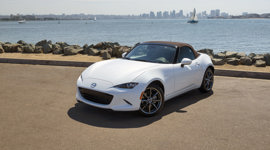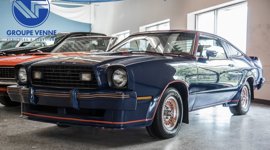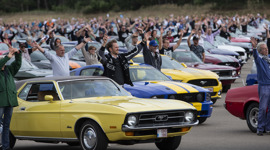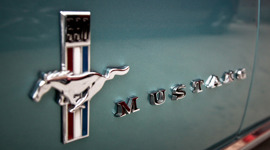BIRMINGHAM, MI – Back in 1995, the city of Ferndale, Michigan, wanted to build a new soccer field. Drawing on the area’s automotive heritage, it organized a drive-along car show that the organizers thought might draw a medium-sized crowd.
Instead, some 250,000 people showed up, and the Woodward Dream Cruise was born. Today, twenty-four years after that first one, it’s estimated that some 40,000 classic cars and a million and a half people descend on a section of Woodward Avenue to celebrate. It’s believed to be one of, if not the largest classic car event in North America.

Detroit may be the Motor City, and Woodward Avenue begins in its downtown core, but the Dream Cruise starts some 20 km north of it in Ferndale and then goes some 26 km to Pontiac. While the cruise is officially on a Saturday, there are events throughout the week prior, and Ferndale’s mayor cuts the ribbon to start it off on Friday night.

Ford is the official auto sponsor of the event and features a “Mustang Alley” display. I spent much of my time surrounded by Mustangs and drove a few along the route – a first-year 1964-and-a-half, a 1966, and a right-hand-drive 2019 Bullitt made for the Australian market – along with a 1950 Ford F-1 and new Ford Fusion police car. (And yes, bringing it back into the parking lot, I indulged my inner eight-year-old by running the lights and siren.)

It might even be possible that Mustang owes something in its development to the road I drove. Almost arrow-straight and with relatively few stop lights or cops, Woodward was popular for cruising in the 1950s and 1960s – and if two cars met up, for a little bit of street racing. Because of that, engineers at the auto companies were known to occasionally take their creations down to Highway M-1, as the street is officially known, to see just what they’d do.

Dream Cruise participants who try that today quickly discover that cops from all jurisdictions are out in full force to keep the peace during the event. That’s important because Woodward doesn’t close for the Dream Cruise. Classic-car participants are asked to keep to the two right lanes, but the street remains open to regular traffic (and the old cars are shooed off the road after 9 pm). That’s part of the fun: spotting a 1926 Dodge Brothers or 1950 Studebaker driving alongside minivans and brand-new pickup trucks.

In its display, Ford included the first Mustang sold, which went to its owner on April 16, 1964. It was actually the first officially sold by a dealer, as Mustang Number One went on a US–Canada tour and was unintentionally sold to airline pilot Captain Stanley Tucker of St. John’s, Newfoundland. After initially turning down Ford’s attempts to buy it back, he took the one-millionth Mustang as a trade in 1966. Neither of those cars was at the show, but the ten-millionth Mustang was, which was built on August 8, 2018.

The 2018 50th Anniversary Cobra Jet was unveiled, built for the drag strip and capable of a quarter-mile in the mid-eight-second range from its supercharged 5.2-L V8. Sixty-eight will be built, to take to the track only, at US$130,000 each. The all-new 2019 Mustang Bullitt was there, released this year in honour of the Steve McQueen movie’s 50th anniversary, along with one exclusively painted blue and accessorized that will be raffled off to benefit the Juvenile Diabetes Research Foundation.

And, alongside the new Bullitt, was the most famous chase-scene car in the country: the 1968 Mustang that McQueen drove in the movie, along with its owner, Sean Kiernan. Two cars were used, one of which was destroyed during jump scenes and ended up in a scrapyard in Mexico. Movie cars were of little value back then and the studio sold the other. Its second owner ran a classified ad for it in Road & Track magazine in 1974 and it was bought by Kiernan’s father Bob, who used it as the family car. He was so fond of it that he turned Steve McQueen down when the actor asked to buy it three years later.

In the late 1980s, father and son began taking the Mustang apart to freshen it up. “Like every other car person on the planet, we had a project car, and ours just happened to be Bullitt,” Kiernan says. The restoration stayed on the back burner, but when Bob Kiernan passed away, Sean felt the car had to be finished.

It’s been put back together but with a minimum of changes; there’s rust on the fenders, and the holes for the camera mounts are still there. It was kept a secret until January 14, 2018, when it was driven out for display at the North American International Auto Show in Detroit alongside the brand-new Bullitt. It’s appeared at a few events since then, including being driven at the Goodwood Festival of Speed this summer. But if Kiernan thought he had the ultimate Bullitt secret, Ford one-upped him at Woodward. He’d previously asked if he could purchase the second 2019 Bullitt built, which was at the show. Instead, Carl Widmann, chief engineer for Mustang, called Kiernan and his wife Samantha up and handed them the keys to it. I later caught up with them as they took a Mustang out to cruise the strip, and they were still in disbelief.

The Mustang disappeared down the street into a sea of taillights: modern LEDs, dim 1940s bulbs, and lights set into 1950s fins and chrome. Woodward Avenue got America’s first mile of paved road in 1916, and at the intersection with Fort Street in downtown Detroit, the world’s first three-colour, four-directional traffic light, invented by a Detroit cop, was put to work in 1920. There’s a lot of history here, and once each summer, it’s all out in full force on four wheels.



























































